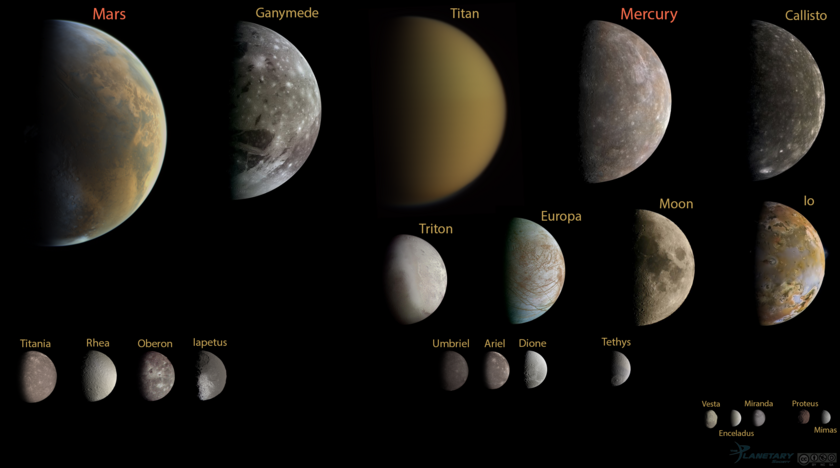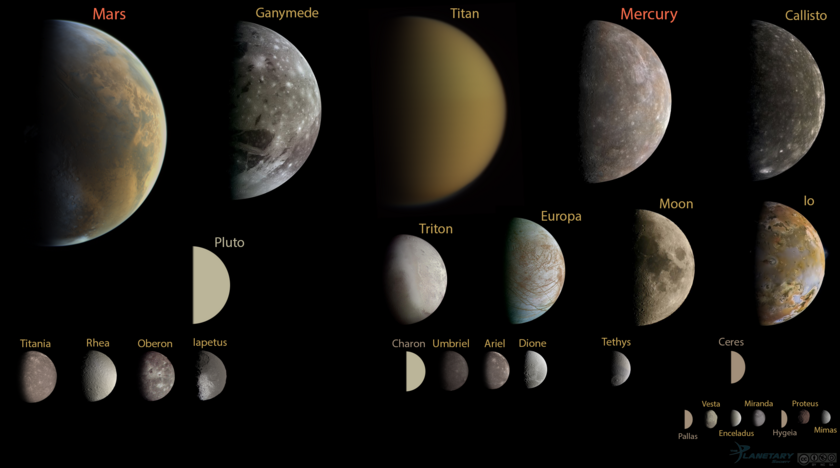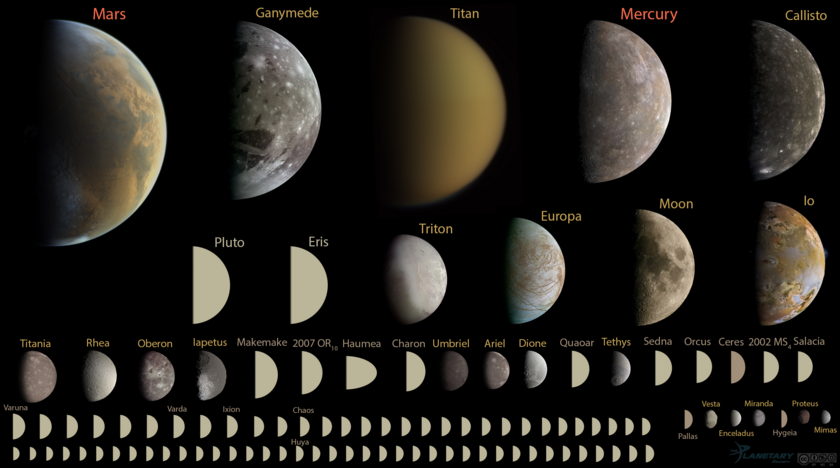Confession time: I'm starting my blog post earlier than I usually do. (rather than the last minute.) I came across a blog site called the Planetary society. In it are featured several blogs from noteworthy astrophysicists. The blog that caught my attention came from Emily Lakdawalla. (Tons of pretty pictures!) In her latest post Emily covers a lot of ground. There's so many things going on out there!
First up: this time next year the New Horizons spacecraft is going to get to Pluto and Charon. They are going to turn those fuzzy dots into actual pictures of the most distant bodies in the solar system. Quick trivia question. How many planets do we have? Some of you are going to say; 'Uh... nine, but now there's eight.' You are partially right. Only until recently have scientists come up with a definition for a planet. It has to be mostly round, over 10,000 kilometers in diameter and has to have had cleaned out the smaller asteroids in it's path. Some of the moons in our system are planet sized themselves, here they are with actual planets beside them for size comparison.

I want to draw your attention to one of those lovely disks. Titan, which is a moon of Saturn, looks a little fuzzy. That's because it is the only moon that has an atmosphere! 'But what about the worlds that are under 10,000 kilometers?'
Well, here they are.

Notice Pluto and Charon are half circles and not actual pictures? That's one of the things that will change next year. That still leaves a lot out. By strict definition these bodies are moons and dwarf planets, but some of these moons are bigger than actual planets. I could put the numbers up, but people have a hard time imagining 1000 kilometers, let alone 10,000 K. But we're not done yet!

This diagram shows most of the planets, moons and dwarf planets in the same size scale range. There are many more. We'd run out of room on this picture. Notice that there are a lot of white semi-circles? That's because we haven't directly seen them. Hell, we haven't even named them yet! Even with our best space based telescopes, they are too far away to make out anything concrete. We can deduce a lot by looking at stuff outside the visual spectrum, but that's nothing compared to what we'd find out by actually going there.
Way back when Voyager II visited Jupiter, a young scientist decided to take a picture of Io, one of Jupiter's moons, in infra-red. Her screen lit up with the discovery of the decade. Voyager had inadvertently captured a volcano going off. A lot of books had to be re-written at that point. That simple stroke of timing and luck turned everything we thought we knew upside down.
Emily's blog is a neat read and I encourage everyone who is perusing my blog to check out what's going on over at the Planetary Society.
Now while the society gets stoked about the universe and invites people to explore for the sake of science, there will still be a bunch of people who will de-fund our scientific adventures. For me, we should explore for the sake of learning about the universe. Detractors who view this as a waste of time and money come from many backgrounds and all walks of life. It would be easy to dump them all into the category of idiots, but I want to offer a less altruistic suggestion. Don't think of them as planets and asteroids, think of them as resources.
Helium-3 is rare on Earth, but evidence collected so far suggests it is abundant on the moon and among the upper layers of the gas giants. What's so special about Helium-3? How about it being a non-radioactive source material sought after for use in nuclear fusion research? It could very well solve our energy problems. If we had more of it, we might be able to turn off our gas, oil and coal plants. A company that establishes a lunar base could mine the resources and profit handsomely in terms of material and power... but why stop there? Ceres and Vesta are right around the corner and waiting to make somebody rich.
And who knows what we will find along the way? I say we find out.
First up: this time next year the New Horizons spacecraft is going to get to Pluto and Charon. They are going to turn those fuzzy dots into actual pictures of the most distant bodies in the solar system. Quick trivia question. How many planets do we have? Some of you are going to say; 'Uh... nine, but now there's eight.' You are partially right. Only until recently have scientists come up with a definition for a planet. It has to be mostly round, over 10,000 kilometers in diameter and has to have had cleaned out the smaller asteroids in it's path. Some of the moons in our system are planet sized themselves, here they are with actual planets beside them for size comparison.

I want to draw your attention to one of those lovely disks. Titan, which is a moon of Saturn, looks a little fuzzy. That's because it is the only moon that has an atmosphere! 'But what about the worlds that are under 10,000 kilometers?'
Well, here they are.

Notice Pluto and Charon are half circles and not actual pictures? That's one of the things that will change next year. That still leaves a lot out. By strict definition these bodies are moons and dwarf planets, but some of these moons are bigger than actual planets. I could put the numbers up, but people have a hard time imagining 1000 kilometers, let alone 10,000 K. But we're not done yet!

This diagram shows most of the planets, moons and dwarf planets in the same size scale range. There are many more. We'd run out of room on this picture. Notice that there are a lot of white semi-circles? That's because we haven't directly seen them. Hell, we haven't even named them yet! Even with our best space based telescopes, they are too far away to make out anything concrete. We can deduce a lot by looking at stuff outside the visual spectrum, but that's nothing compared to what we'd find out by actually going there.
Way back when Voyager II visited Jupiter, a young scientist decided to take a picture of Io, one of Jupiter's moons, in infra-red. Her screen lit up with the discovery of the decade. Voyager had inadvertently captured a volcano going off. A lot of books had to be re-written at that point. That simple stroke of timing and luck turned everything we thought we knew upside down.
Emily's blog is a neat read and I encourage everyone who is perusing my blog to check out what's going on over at the Planetary Society.
Now while the society gets stoked about the universe and invites people to explore for the sake of science, there will still be a bunch of people who will de-fund our scientific adventures. For me, we should explore for the sake of learning about the universe. Detractors who view this as a waste of time and money come from many backgrounds and all walks of life. It would be easy to dump them all into the category of idiots, but I want to offer a less altruistic suggestion. Don't think of them as planets and asteroids, think of them as resources.
Helium-3 is rare on Earth, but evidence collected so far suggests it is abundant on the moon and among the upper layers of the gas giants. What's so special about Helium-3? How about it being a non-radioactive source material sought after for use in nuclear fusion research? It could very well solve our energy problems. If we had more of it, we might be able to turn off our gas, oil and coal plants. A company that establishes a lunar base could mine the resources and profit handsomely in terms of material and power... but why stop there? Ceres and Vesta are right around the corner and waiting to make somebody rich.
And who knows what we will find along the way? I say we find out.

No comments:
Post a Comment